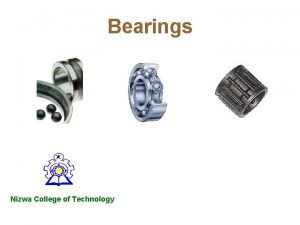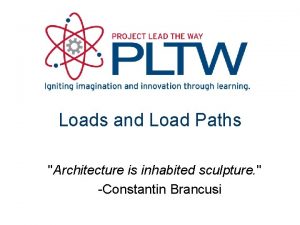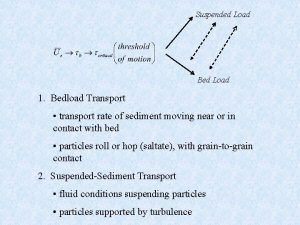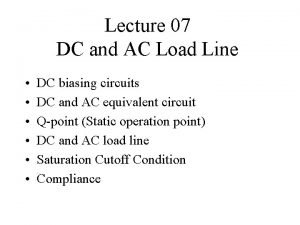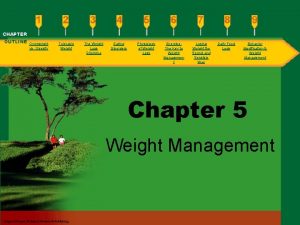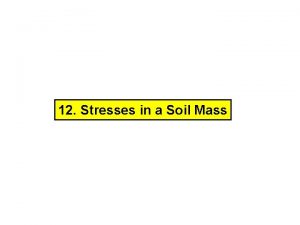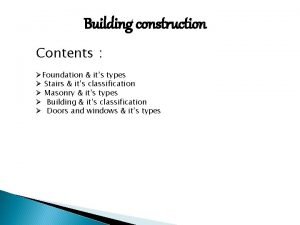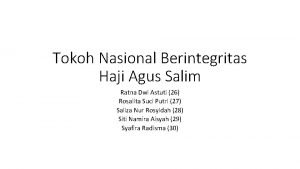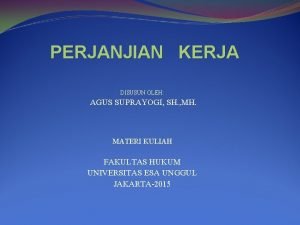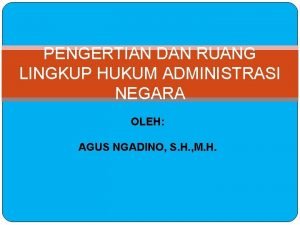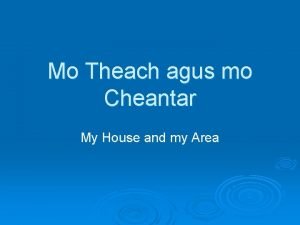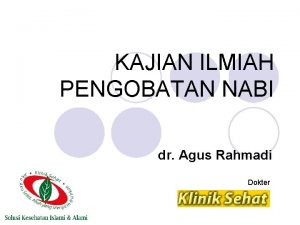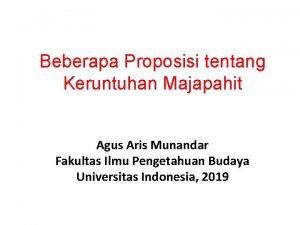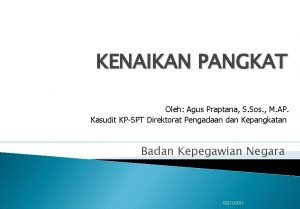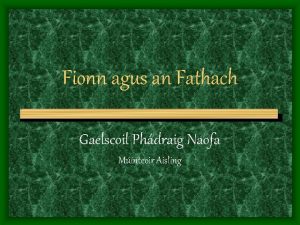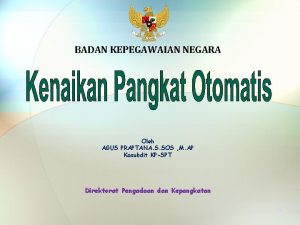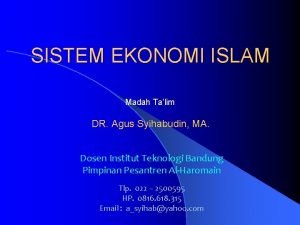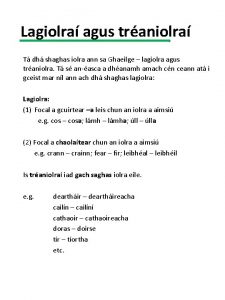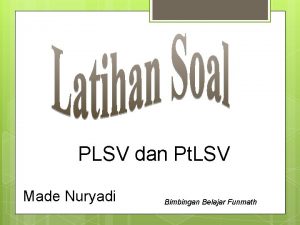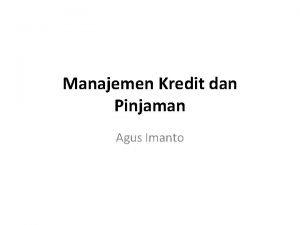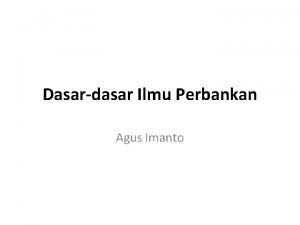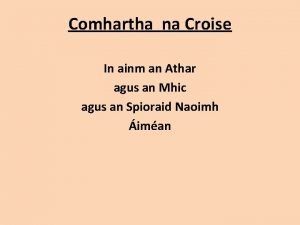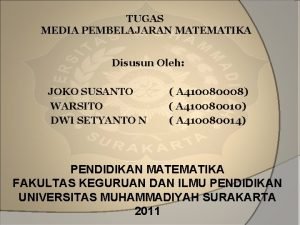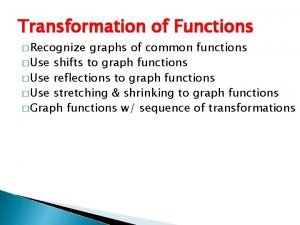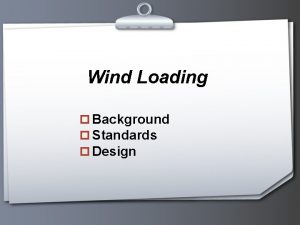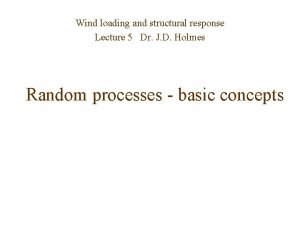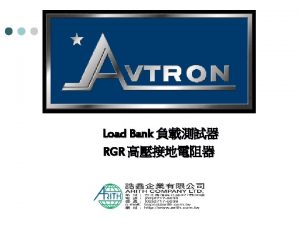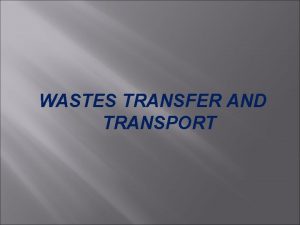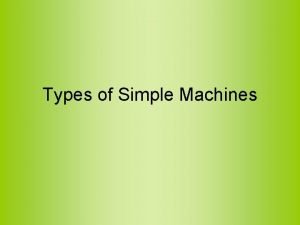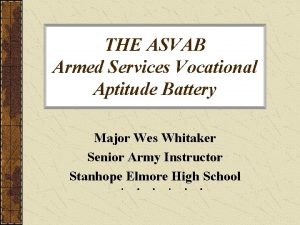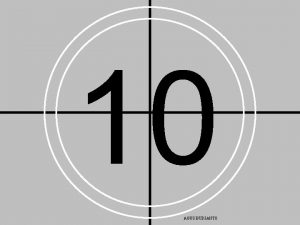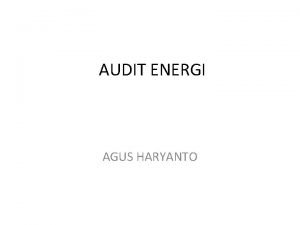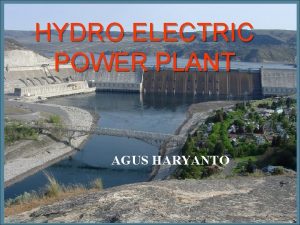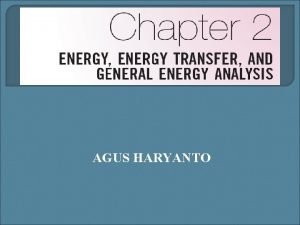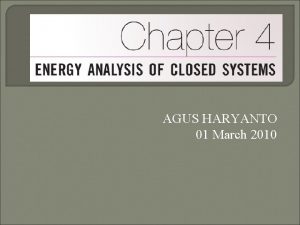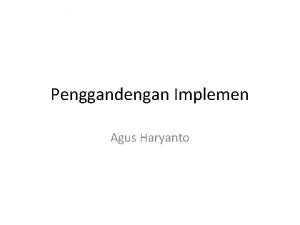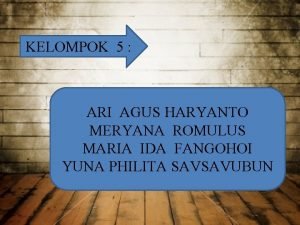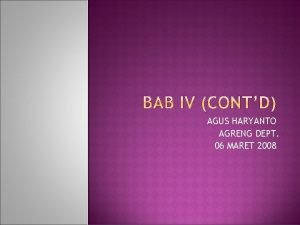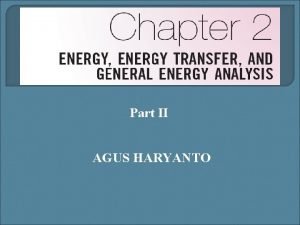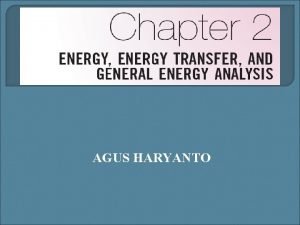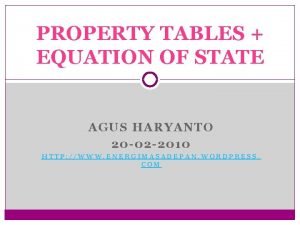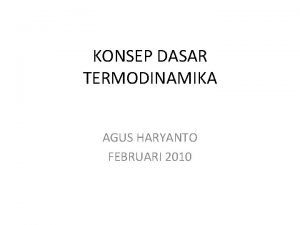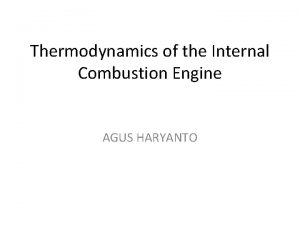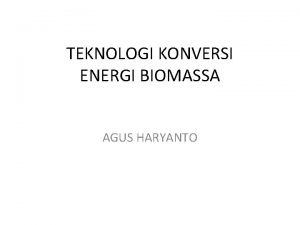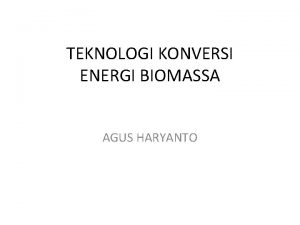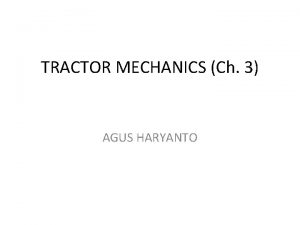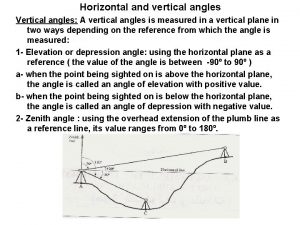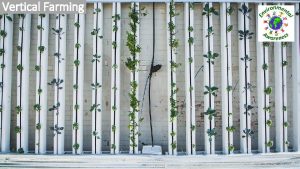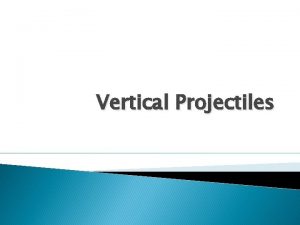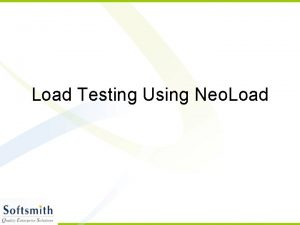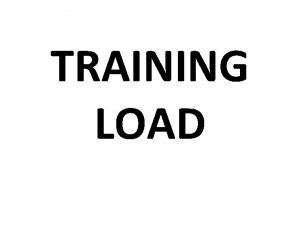AGUS HARYANTO TERMINOLOGY i Vertical load or weight







![THEORETICAL PREDICTION Pz = [(Kc/b) + K ] log • • n Z Pz THEORETICAL PREDICTION Pz = [(Kc/b) + K ] log • • n Z Pz](https://slidetodoc.com/presentation_image_h/bf45cb2233808f5b7fb2a187240549f9/image-8.jpg)





























- Slides: 37

AGUS HARYANTO

TERMINOLOGY i. Vertical load or weight on the wheel, W is the vertical force through the axle. ii. Travel (output) speed, V is the linear speed of driven wheel; Travel speed < Rotational speed x Rolling radius iii. Rolling radius, r, is defined in terms of the ‘distance traveled per revolution’/2π under “zero conditions. ” iv. Wheel-slip, i = (Vo – V)/Vo atau i = (mo – m)/mo v. Input torque, T, is the (rotational) input effort on driven wheel which is converted to (linear) output effort (force or drawbar pull); Drawbar pull < Input torque/Rolling radius

TERMINOLOGY vi. Rolling (motion) resistance, R is the force opposing motion of the wheel (in the horizontal direction) that arises from the non- recoverable energy expended in deforming the surface and wheel. vii. Tractive force, H is the horizontal reaction on a driven wheel by the soil in the contact area; it is equal and opposite to the horizontal force generated by the wheel on the soil. viii. Drawbar pull, P is the horizontal force at the axle generated by a driven wheel. From H = P + R P = H – R ix. Towing force is the force to move a freely rolling wheel over the surface and is equal and opposite to the rolling resistance. P

Operational states of a wheel a) Towed Wheel is towed with zero opposing external torque; the unknown parameter is the R. b) Self-propelled Wheel is driven by external input torque to overcome R and to propel with no drawbar pull. The unknown is R. c) Driven Wheel is driven by external input torque and to develop a drawbar pull. The unknown is i. Extreme case: no move. d) Braked Wheel is towed against an opposing, external torque. The unknown is i. Extreme case: wheel skids.



![THEORETICAL PREDICTION Pz Kcb K log n Z Pz THEORETICAL PREDICTION Pz = [(Kc/b) + K ] log • • n Z Pz](https://slidetodoc.com/presentation_image_h/bf45cb2233808f5b7fb2a187240549f9/image-8.jpg)
THEORETICAL PREDICTION Pz = [(Kc/b) + K ] log • • n Z Pz = log [(Kc/b) + K ] + n log Z z is vertical soil deformation (sinkage) Kc and Kφ are soil sinkage moduli n is soil sinkage exponent b is the width of the plate

SOIL APARATUS


WORK TO DEFORM SOIL

SOFT WHEEL ON SOFT SURFACE • Consider the work done in towing such a wheel a distance, l against the rolling resistance, R. In simple terms, if this is equal to the work done on forming the rut as for the plate, length l, width b pressed into the soil, then:


SOFT WHEEL ON SOFT SURFACE Untuk n = 1

RIGID WHEEL ON SOFT SURFACE


TRACTIVE FORCE Shear stress - deformation characteristic for soil S = Smax (1 – e-j/k) Smax = (c + σ tan φ) S = (c + σ tan φ) (1 – e-j/k) Where: c = soil cohesion φ = angle of internal friction σ = normal stress j = shear deformation k = shear deformation modulus



Analysis of track

Graphic H vs W

WORK EXAMPLES

Solution b

EXAMPLE 2 A rubber wheel carrying a load W of 5. 4 k. N has an effective ground contact area A of 0. 09 m 2 over which the pressure may be assumed to be uniform. The soil and rubber / soil strength characteristics are shown in Figure 4. 13. What is the maximum pull which can be generated by the wheel if: (i) the wheel has lugs which engage the soil? (ii) the lugs are removed?


SOLUTION

Analysis of track with slip H = Hmax (X) Note: For rubber tire, contact area A = 0. 78 b l.

DRAWBAR PULL, P = H - R • (i) tracks compared to 2 WD on cultivated (loose) soil which shows the effect of area and length of contact patch and of weight • (ii) tracks on stubble (firm) compared to cultivated (loose) soil which shows the effect of soil strength and rigidity (deformation modulus) • (iii) 4 WD compared to 2 WD on cultivated (loose) soil which shows the effect of area and weight.



TUGAS (PR, individual) Buatlah kurva gaya traksi (H) vs. selip (i) dan drawbar pull (P) vs. selip (i). Data berikut berlaku


DRAWBAR POWER Wheel-slip - drawbar power

EXAMPLE

optimum wheel-slip


 Thrust load bearing
Thrust load bearing Load paths
Load paths Suspended load definition
Suspended load definition Dc load line definition
Dc load line definition Tolerable weight
Tolerable weight Bulk reducing industry in a sentence
Bulk reducing industry in a sentence Vertical stress due to strip load
Vertical stress due to strip load Types of stairs in building construction
Types of stairs in building construction Integritas h.agus salim
Integritas h.agus salim Agus suprayogi
Agus suprayogi Agus ngadino
Agus ngadino Mo theach agus mo cheantar
Mo theach agus mo cheantar Dokter agus rahmadi
Dokter agus rahmadi Agus aris munandar
Agus aris munandar Agus praptana bkn
Agus praptana bkn Fionn agus an fathach
Fionn agus an fathach Agus praptana bkn
Agus praptana bkn Agus syihabudin
Agus syihabudin Lagiolraí agus tréaniolraí
Lagiolraí agus tréaniolraí Umur pak agus 3 kali umur iwan
Umur pak agus 3 kali umur iwan Agus imanto
Agus imanto Agus imanto
Agus imanto In ainm an athar
In ainm an athar Umur pak agus 3 kali umur iwan
Umur pak agus 3 kali umur iwan Agus superiadi
Agus superiadi Agus suprayogi
Agus suprayogi Pengertian geografi budaya
Pengertian geografi budaya Vertical shrink
Vertical shrink P=fxd/t
P=fxd/t Wind load calculation example bs 6399
Wind load calculation example bs 6399 Load response correlation
Load response correlation Dummy load bank
Dummy load bank Direct load transfer station
Direct load transfer station Vehicle load card
Vehicle load card Lever
Lever Power bi extract transform load
Power bi extract transform load Y connected generator
Y connected generator Which post holds up the greater part of the load
Which post holds up the greater part of the load
